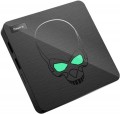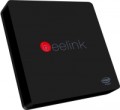Operating system
—
Proprietary system. The operating system of the device is represented by the proprietary software shell of the manufacturer. Usually, such operating systems have an attractive and convenient menu. A proprietary operating system is developed directly by the manufacturer for the hardware resources of a particular model or a whole line, but has limited capabilities.
—
Android (AOSP). This type of operating system is a modification of the popular Android OS, mainly notable for being open source. It is a versatile operating system that gives the user much more freedom to create changes and customizations within the system itself. At the same time, the installation and stability of certain applications on this platform are not guaranteed, and the overall system management was not specially “tailored” for large screens, which may cause some inconvenience. First of all, such solutions will interest users who understand the features of the Android OS, like to customize and control everything for themselves, and have time for this.
—
Android TV. Devices of this type have full-fledged Android TV software, specially adapted to work on large screens. In accordance with the name, it is a type of Android OS, specially designed for such equipment. In addition to the common features of all Androids (such as the ability to install additional applications, including
...even games), it has a number of special features: an optimized interface, integration with smartphones (including the ability to use them as a remote control), voice search, etc. Thanks to this, TVs with this feature are significantly superior in functionality to models with a “regular” Smart TV. Of course, a dedicated processor, graphics subsystem and memory are provided for the operation of a multifunctional OS, and the presence of such hardware resources is reflected in the overall cost.
— Google TV. Rebranding of the Android TV platform for TVs and smart consoles, or rather, a new shell on top of the operating system under the sign of the “green droid”, introduced since 2021. Among the innovations, it has a redesigned user interface, an improved knowledge base that more efficiently distributes content by genre and collects search information from the entire list of installed applications and subscriptions. The voice assistant now understands the needs of the audience better and provides a detailed list of what was found. A separate tab in the interface contains live broadcasts of current events, whether it be sports events or a rocket launch to Mars. Among other things, the aspects that involve the use of TV as a command post for managing a single ecosystem of a “smart” home have been improved in the system.Bluetooth
Bluetooth is a technology used to connect various devices wirelessly directly. In media centers and TV receivers, it can be used to broadcast sound to wireless headphones and acoustics, to work with wireless mice and keyboards, to use a smartphone / tablet as a remote control, etc.; specific functionality should be specified separately. Also note that the supported version of Bluetooth can be specified here. The newest and most advanced is
Bluetooth 5.0, but here is a more detailed description of the different versions:
- Bluetooth v4.0. The version in which the "Bluetooth Low Energy" (LE) format was first introduced — in addition to regular Bluetooth (version 2.1 functionality) and the high-speed HE standard for transferring large amounts of information (introduced in version 3.0). Bluetooth LE allows you to significantly reduce power consumption when transmitting small data packets, such as request-responses about connection activity in idle mode. For the media centers and TV receivers themselves, this is not particularly important, but for portable equipment (especially miniature ones, where battery capacity is very limited), such functionality will be useful.
- Bluetooth v 4.1. Development and improvement of Bluetooth 4.0. One of the key improvements was the optimization of collaboration with 4G LTE communication modules so that Bluetooth and LTE do not interfere with each other. In addition, this ve...rsion has the ability to simultaneously use a Bluetooth device in several roles — for example, to remotely control an external device while simultaneously streaming music to headphones.
- Bluetooth v4.2. Further, after 4.1, the development of the Bluetooth standard. It did not introduce fundamental updates, but received a number of improvements regarding reliability and noise immunity, as well as improved compatibility with the Internet of Things.
- Bluetooth v5.0. Version introduced in 2016. One of the most notable updates was the introduction of two new modes of operation for Bluetooth LE — with an increase in speed by reducing the range and with an increase in range by reducing the speed. In addition, a number of improvements have been introduced regarding simultaneous work with numerous connected devices, as well as work with the components of the Internet of Things.
Wi-Fi
Wi-Fi is a technology used for wireless connection to computer networks and for direct connection between devices. In media players, tuners and video capture devices, it can be used both to access the Internet or "local area" through a wireless router, and to communicate with a smartphone, tablet, etc. The
AirPlay, Chromecast and Miracast functions are also based on this technology. The specific set of Wi-Fi features should be clarified separately; here we note that in this paragraph the specific supported version of such a connection can also be specified. Here are the main current options:
- Wi-Fi 5(802.11ac). One of the newest (for 2020) standards. Uses the 5 GHz band (less crowded than used in earlier 2.4 GHz versions) for improved reliability and lower latency; and speeds can reach 6.77 Gbps with multiple antennas and 1.69 Gbps with a single antenna.
- Wi-Fi 4 (802.11n). The predecessor of the above Wi-Fi 5, the first standard in which the 5 GHz band was introduced — here it is used along with the traditional 2.4 GHz and is not supported by some devices with Wi-Fi 4. Data transfer rate — up to 600 Mbps.
Note that, in addition to the directly claimed Wi-Fi standard, the media centre, digital receivers and video capture devices usually provide support for earlier versions — for maximum compatibility with different devices.
AirPlay
The technology of broadcasting audio and video signals through a Wi-Fi connection. Widely used in Apple electronics, the media centre with AirPlay will make it easy to duplicate a “picture” on a TV, for example, from an iPhone or iPad. The main disadvantage of this technology compared to similar Miracast is the need for a local network with a wireless router.
Miracast
A wireless technology that allows you to directly broadcast video and audio from one device to another directly over a Wi-Fi connection. At the same time, unlike AirPlay, transmission does not require a router and building a local network — it is enough that the receiver and transmitter are compatible with Miracast. One of the most popular ways to use this technology is to output a “picture” from a smartphone / tablet screen to a TV, and vice versa.
A media centre or TV receiver with Miracast is useful if the TV itself does not support this function.
AV output
—
AV output. Analogue output for video and audio transferring. Previously, due to the large size of the equipment, it consisted of 3 RCA jacks and was connected to the TV accordingly. Now the devices have become more compact and don't have free space on the case. Therefore, the AV output is a single headphone jack, to which a tee cable is already connected (check availability in the package). Since all components of the video signal are on the same cable, the picture quality and immunity to interference are low.
Optical output
A variation of the SP/DIF audio interface that uses a TOSLINK fibre optic cable. Like the coaxial connector,
the optical output uses a digital data transfer format and can work with multi-channel audio. At the same time, optical fibre requires rather delicate handling, but it is absolutely insensitive to electrical interference.
Audio output (3.5 mm)
The presence of an audio output in most cases implies
a 3.5 mm mini-Jack connector for headphones. This connector does not transmit high power, which can fully supply the TV with an audio signal, but for compact devices, which include headphones, it will come in handy, since most household wired headphones are produced with a 3.5 mm plug. Headphones can be useful in noisy environments, or vice versa, when loud sound is undesirable, as well as in situations where sound must be listened to attentively (for example, when listening to radio broadcasts to learn a foreign language).
CPU
The model of the CPU installed in the media player.
This information is mainly of reference value: the processor is selected in such a way as to provide certain practical characteristics (maximum resolution, support for certain standards, embedded applications, etc.). So when choosing, you should focus primarily on these specifications. However, if you wish, knowing the processor model, you can find detailed data on it and evaluate the capabilities of the media centre to work with resource-consuming applications. This can be useful, in particular, if you choose an Android model (see above) and plan to use additional software intensively — the set of applications for this OS is very extensive, and some of them are quite demanding on system resources.
Also note that CPU data is often specified for advertising purposes — to emphasize that the device has a fairly advanced chip from a well-known brand. Among the most common brands of such processors are
Allwinner,
Amlogic,
Rockchip,
Realtek.

